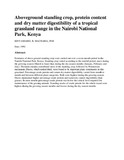| dc.contributor.author | KINYAMARIO, JI | |
| dc.contributor.author | MACHARIA, JNM | |
| dc.date.accessioned | 2013-06-18T15:41:08Z | |
| dc.date.available | 2013-06-18T15:41:08Z | |
| dc.date.issued | 1992 | |
| dc.identifier.citation | African Journal of Ecology Volume 30, Issue 1, pages 33–41, March 1992 | en |
| dc.identifier.uri | http://onlinelibrary.wiley.com/doi/10.1111/j.1365-2028.1992.tb00476.x/abstract | |
| dc.identifier.uri | http://erepository.uonbi.ac.ke:8080/xmlui/handle/123456789/35895 | |
| dc.description.abstract | Estimates of aboveground standing crop were carried out over a seven-month period in the Nairobi National Park, Kenya. Standing crop varied according to the rainfall period, more during the growing season (March to June) than during the dry season months (January, February and July). Themeda triandra contributed most of the standing crop, followed by Pennisetum mezianum. Dicots, which ranked third, were found to be important plant constituents in this grassland. Percentage crude protein and rumen dry matter digestibility varied from month to month and between different plant categories. Both were highest during the growing season. Dicots maintained higher percentage crude protein and rumen dry matter digestibility than grasses. In most months percentage crude protein was below the critical level required for maintenance of the grazing animals. Standing stocks of crude protein for the whole sward were highest during the growing season months and lowest during the dry season months. | en |
| dc.language.iso | en | en |
| dc.publisher | Wiley | en |
| dc.subject | Standing crop | en |
| dc.subject | protein | en |
| dc.subject | digestibility | en |
| dc.subject | grassland | en |
| dc.subject | range | en |
| dc.title | Aboveground standing crop, protein content and dry matter digestibility of a tropical grassland range in the Nairobi National Park, Kenya | en |
| dc.type | Article | en |

